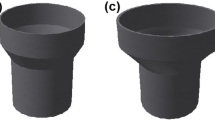Abstract
The flaring of tube ends are typically performed using electromagnetic forming, or punch-and-die method, both of which cost time and effort. In this work, a new method of tube flaring using a metal spinning process is proposed. An experimental study was carried out to flare the end of aluminium tubes. A multifunction tool was designed based on the flaring ratio to widen the tube end. Several flared specimens were conducted at different working conditions. The effects of working conditions such as flaring ratio, axial feed rate (mm/rev), and rotating speed (rpm) on the flaring loads were investigated. An experimental analysis was carried out to illustrate the effect of the working conditions on the characteristics of the formed part. The analysis showed that these working conditions have a clear influence on wall thickness, surface hardness, and flaring loads.
Similar content being viewed by others
References
Jianguo Y, Makoto M (2002) An experimental study on paraxial spinning of one tube end. J Mater Process Technol 128:324–329
Jianguo Y, Makoto M (2002) Effects of indented feed of roller tool on parallel spinning of circular aluminium tube. J Mater Process Technol 128:274–279
El-Sheikh MN (1996) Spinning of aluminium cups assisted with a constant pressure blank-holder. Proceeding of conf. MDP7, Faculty of Engineering, Cairo university, (1996) 2–4
Jianguo Y, Makoto M (2005) An experimental study on spinning of taper shape on tube end. J Mater Process Technol 166:405–410
Alves LM, Pardal TCD, Martins PAF (2010) Nosing thin-walled tubes into axisymmetric seamless reservoirs using recyclable mandrels. J Cleaner Product 18:1740–1749
Huang YM (2008) Flaring and nosing process for composite annoy tube in circular cone tool application. Int J Adv Manuf Technol 43–11:1167–1176
Lu Y (2005) Study of preform and loading rate in the tube nosing process by spherical die. Comput Methods Appl Mech Eng 194:2839–2858
Huang Y, Huang Y (2001) Elasto-plastic finite element analysis of the axisymmetric tube-flaring process with conical punch. Int J Adv Manuf Technol 18:390–398
Lu Y (2004) Study of tube flaring ratio and strain rate in the tube flaring process. Finite Elem Anal Des 40:305–318
Putten K, Werff K, Steinhoff K, Fontijne J (2003) Towards modelling elastic–plastic deformation of a tube-shaped work-piece under axisymmetric load. Steel Res 74:168–175
Manabe K, Nishimura H (1982) Forming loads and forming limits in conical nosing of tubes—study on nosing and flaring of tubes. J Japan Soc Technol Plasticity 42:23–335
Barsoum I, Khan F, Molki A, Seibi A (2014) Modeling of ductile crack propagation in expanded thin-walled 6063-T5 aluminum tubes. Int J Mech Sci 80:160–168
Li J, Gao G, Dong H, Xie S, Guan W (2016) Study on the energy absorption of the expanding–splitting circular tube by experimental investigations and numerical simulations. J Thin-Walled Structures 103:105–114
Yang J, Luo M, Hua Y, Lu G (2010) Energy absorption of expansion tubes using a conical–cylindrical die: experiments and numerical simulation. Int J Mech Sci 52:716–725
Yan J, Yao S, Xu P, Peng Y, Shao H, Zhao S (2016) Theoretical prediction and numerical studies of expanding circular tubes as energy absorbers. Int J Mech Sci 105:206–214
Fischer FD, Rammerstorfer FG, Daxner T (2006) Flaring—an analytical approach. J Mech Sci 48:1246–1255
Niknejad A, Moeinifard M (2012) Theoretical and experimental studies of the external inversion process in the circular metal tubes. J Mater Des 40:324–330
Thomas JD, Seth M, Daehn GS, Bradley JR, Triantafyllidis N (2007) Forming limits for electromagnetically expanded aluminium alloy tubes: theory and experiment. Acta Mater 55:2863–2873
Jeanson A, Bay F, Jacques N, Avrillaud G, Arrigoni M, Mazars G (2016) A coupled experimental/numerical approach for the characterization of material behavior at high strain-rate using electromagnetic tube expansion testing . doi:10.1016/j.ijimpeng.2016.07.002Int J Impact Eng
Murata M, Suzuki H (1990) Profile control in tube flaring by electromagnetic forming. J Mater Process Technol 22:75–90
Zhang JM, Qing Y, Yu-rong W, Wei-lin X, Jian-gang C (2011) Experimental investigation of cavitation in a sudden expansion pipe. J Hydrodynamics 23(3):348–352
Yan X, Qu Z, Kong D (2008) Relationship between rotating sunspots and flare productivity. Mon Not R Astron Soc 391:1887–1892
Author information
Authors and Affiliations
Corresponding author
Rights and permissions
About this article
Cite this article
Khalil Hazawi, A.R., Abdel-Magied, R.K. & Elsheikh, M.N. An experimental analysis of a flaring process for tube ends using a novel spinning tool. Int J Adv Manuf Technol 92, 157–165 (2017). https://doi.org/10.1007/s00170-017-0106-7
Received:
Accepted:
Published:
Issue Date:
DOI: https://doi.org/10.1007/s00170-017-0106-7




